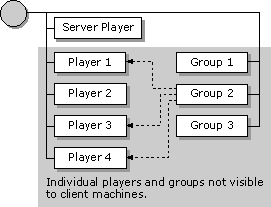
| Platform SDK: DirectX |
In a DirectPlay client/server session, one computer is designated the server. Like the peer-to-peer name server, this computer responds to enumeration requests, regulates computers trying to join the session, downloads the session's state to new computers that have joined, and generates ID numbers as players and groups are created. The client/server model differs from the peer-to-peer model in that all messages in the session are routed through the server.
The server computer runs a special version of the application (the application server) that can maintain the master state of the game, updating that state according to actions that the client computers take, and notifying individual clients of relevant events. The application server creates a special player called the server player. Any client computer can send a message directly to the server player or receive a message from the server player. When the server player receives a message, it can send messages to other client players to inform them of a change in state.
The following diagram illustrates client/server communications. Each machine communicates directly with the server only. The server can forward messages to other clients.

The client computers run client versions of the application that can maintain the local state, updating the state in response to messages from the server, and sending messages to the server when local action occurs.
You can implement a client/server application in two ways. One mode is a hybrid peer-to-peer and client/server session, where every client application has the complete player and group list available to it (including the server player). Any client player can send a message directly to any player in the session, and each player or group can have data associated with it (such as name or remote data) that will be updated on all the computers whenever it changes. All the benefits of peer-to-peer state propagation are available, and, in addition, a server player is available. However, you cannot control the propagation of the player-to-player data. Depending on the frequency with which players and groups are created and destroyed or their data changes, client computers could be overloaded with incoming messages. This type of session is not scalable beyond about 16 players. It is not very different from a peer-to-peer session, except that it has a server player, all messages are routed through the server, and the server player will receive a copy of all the messages that pass through the server.
The second mode is pure client/server. Each client application sees only the server player and its own local players in the session. A client player can send messages only to the server player and receive messages from only the server player. The application server can see all the players on all clients. When the server receives a message from a client, it can intelligently decide how to update the master application state and inform the clients that need to be notified of this update. In this mode, the client application must manage the player list and the data associated with each player.
The following diagram shows a logical representation of the contents of a DirectPlay client/server session.

As in a peer-to-peer session, the session's network address corresponds to the server's network address. When a computer needs to join the session, it sends the join request to the server. In response, the server downloads the session's state to the new computers. If the server leaves the session, the session is terminated.
Because all messages are routed through the server, it automatically behaves as a multicast server.